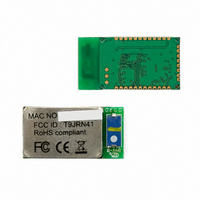RN-41 Roving Networks Inc, RN-41 Datasheet - Page 6

RN-41
Manufacturer Part Number
RN-41
Description
MODULE BLUETOOTH W/ANT CLASS1
Manufacturer
Roving Networks Inc
Specifications of RN-41
Frequency
2.4GHz
Data Rate - Maximum
2Mbps
Modulation Or Protocol
Bluetooth v2.0+EDR, Class 1 & 2
Applications
Bluetooth v2.0
Power - Output
15dBm
Sensitivity
-80dBm
Voltage - Supply
3 V ~ 3.6 V
Current - Receiving
35mA
Current - Transmitting
65mA
Data Interface
PCB, Surface Mount
Memory Size
8MB Flash
Antenna Connector
PCB, Surface Mount
Operating Temperature
-40°C ~ 85°C
Package / Case
Module
Wireless Frequency
2.402 GHz to 2.48 GHz
Interface Type
UART, USB, PCM
Data Rate
721 Kbps to 2 Mbps
Modulation
FHSS, GFSK
Operating Voltage
3.3 V
Antenna
Chip Antenna
Board Size
13.2 mm x 25.8 mm x 2.05 mm
Operating Temperature Range
- 40 C to + 85 C
Security
128 bit Encryption
Lead Free Status / RoHS Status
Lead free / RoHS Compliant
Lead Free Status / RoHS Status
Lead free / RoHS Compliant, Lead free / RoHS Compliant
Other names
740-1007
Design Concerns
1. Reset circuit. RN-41 contains a 1k pullup to VCC, the polarity of reset on the RN41 is ACTIVE LOW.
2. Factory reset PIO4. It is a good idea to connect this pin to a switch, or jumper, or resistor, so it can be
3. Connection status. PIO5 is available to drive an LED, and blinks at various speeds to indicate status.
4. HCI mode. The RN41 module must be loaded with special firmware to run in HCI mode. When in HCI
5. Using SPI bus for flash upgrade. While not required, this bus is very useful for configuring advanced
6. Minimizing Radio interference.
7. Soldering Reflow Profile.
A power on reset circuit with delay is OPTIONAL on the reset pin of the module. It should only be required
if the input power supply has a very slow ramp, or tends to bounce or have instability on power up.
a microcontroller or embedded CPU IO is available to generate reset once power is stable. If not, there
are many low cost power supervisor chips available, such as MCP809, MCP102/121, and Torex XC61F.
accessed. This pin can be used to reset the module to FACTORY DEFAULTS and is often critical in
situations where the module has been mis-configured. To set Factory defaults start HIGH, then toggle
times.
PIO2 is an output which directly reflects the connection state, it goes HIGH when connected, and LOW
otherwise.
mode the standard SPP/DUN applications are disabled.
parameters of the Bluetooth modules, and is required for upgrading the firmware on modules. The
suggested ref-design shows a 6pin header which can be implemented to gain access to this bus. A
minimum-mode version could just use the SPI signals (4pins) and pickup ground and VCC from elsewhere
on the design.
When laying out the carrier board
for the RN41 module the areas
under the antenna and shielding
connections should not have
surface traces, GND planes, or
exposed vias. (See diagram to right)
For optimal radio performance the
antenna end of RN41 module
should protrude 5mm past any
metal enclosure.
•
•
•
•
809 University Avenue
Lead-Free Solder Reflow
Temp: 230 degree C , 30-40
seconds, Peak 250 degree C
maximum.
Preheat temp: 165 +- 15
degree C, 90 to 120 seconds.
Time: Single Pass, One Time
•
Los Gatos, CA 95032
Do not locate any
Do not locate any
plane under the
plane under the
traces, internal
traces, internal
traces or GND
traces or GND
parts, surface
parts, surface
antenna area
antenna area
ATTENTION:
ATTENTION:
•
Tel (408) 395-6539
1.5 mm
1.5 mm
1.5 mm
1.5 mm
7.0 mm
7.0 mm
10
10
11
11
12
12
1
1
2
2
3
3
4
4
5
5
6
6
7
7
8
8
9
9
35
35
vias or surface
vias or surface
1.5mm square
1.5mm square
Do not locate
Do not locate
29
29
ATTENTION:
ATTENTION:
traces under
traces under
DS-RN41-V3.1 8/31/2010
connectors
connectors
1.5 mm
1.5 mm
34
34
• info@RovingNetworks.com
13.2 mm
13.2 mm
shield
shield
33
33
32
32
31
31
27 25
27 25
28
28
30
30
24
24
23
23
22
22
21
21
20
20
19
19
18
18
17
17
16
16
15
15
14
14
13
13
1.5 mm
1.5 mm
1.5 mm
1.5 mm
25.8 mm
25.8 mm
2.0 mm
2.0 mm
Often




















